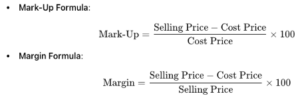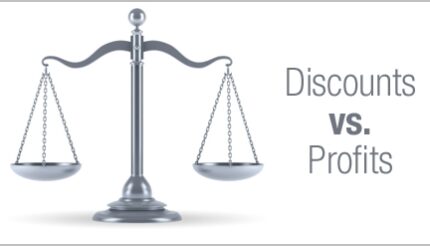There’s a fine line between thriving and barely surviving in the business world. And often, that line comes down to knowing your numbers—specifically, understanding the difference between markup and margin.
If you’ve ever felt confused by these terms, don’t worry—you’re not alone. Plenty of business owners have mixed them up, and as a result, they’ve seen profits vanish or even lost out on opportunities. But here’s the good news: once you master these two concepts, you’ll have a powerful tool to help you grow your business, make more intelligent pricing decisions, and boost your bottom line.
Let’s dive into how understanding markup and margin can be the secret weapon that sets you apart. We’ll look at real-life examples of businesses that have used these concepts to their advantage, so you can see how it’s done.
The Problem: Confusing Markup and Margin Can Cost You
You’re an entrepreneur or a business owner who wants to succeed. But there’s a challenge in your way: pricing your products correctly. If you’re not careful, confusing markup with margin can lead to underpricing (goodbye, profit!) or overpricing (hello, lost customers!). And no one wants to leave money on the table or drive customers away.
Here’s the key: markup and margin play a role in pricing, but they’re not the same. Misunderstanding them is like putting the wrong ingredients in a recipe—it throws everything off. Let’s address some common misconceptions about these terms to ensure you have a clear understanding.
So, what’s the difference? And more importantly, how do you use these concepts to ensure your business is profitable?
Ready to Take Control of Your Profits
Right now, you may be in the dark regarding markup and margin. You may have even made pricing mistakes because of it, and you’re wondering how to fix it. Don’t worry—you’re in the right place.
You are in control of this story, and the great news is that with just a little bit of knowledge, you can take control of your pricing, make smarter decisions, and ultimately grow your business. All you need is the right guide to help you along the way.
The Guide: Let’s Break It Down (No Complicated Jargon Here)
Consider me your guide in this journey to mastering markup and margin. Together, we will clarify these concepts so you can use them to your advantage.
What is Markup?
Imagine you’re running a business selling high-end coffee mugs. You buy each mug for £10. You don’t just want to sell it at cost—you want to make a profit. So, you decide to sell it for £15.
The extra £5 you’ve added to the price is your markup. It’s the amount you add to the cost to reach your selling price.
- Cost price: £10
- Selling price: £15
- Markup: £5
But businesses often talk in percentages, not just numbers. So, to calculate your markup percentage, divide that £5 by the cost price (£10):
![]()
So, you’ve marked up your coffee mugs by 50%. It’s that simple.
What is Margin?
Now, let’s look at the margin. While markup is focused on how much you add to the cost price, margin tells you what percentage of the final selling price is profit.
Using the same example, you sell the coffee mug for £15, which costs you £10. That gives you a profit of £5. To find the margin, you divide that £5 profit by the selling price (£15):
![]()
Your margin is 33.3%. While your markup was 50%, your margin is lower because the margin is based on the final selling price, not the cost.
Formulas to Remember
How to Use Markup and Margin Like a Pro
Knowing the difference between markup and margin is great, but now you need a plan for when to use each one. Here’s a simple, foolproof way to think about it:
- Use markup when you’re setting prices. If you know how much it costs to make or buy a product, markup helps you determine what to charge. It’s a tool for determining how much profit you want over your costs. Understanding price elasticity can also help you set the right markup, as it shows how changes in price affect demand.
- Use margin when you’re reviewing your sales. If you want to know how profitable your sales have been or track how much of each sale is actual profit, look at your margin. It’s a tool for evaluating how well your business is performing.
Why Getting This Right Matters
Here’s the truth: if you confuse markup with margin, you might accidentally undercharge your customers or overcharge them. Both mistakes can cost you, either by shrinking your profits or losing sales. This underscores the importance of avoiding these mistakes and staying attentive to your pricing strategy.
Imagine you wanted a 50% margin but calculated a 50% markup instead. You’d set your selling price too low, meaning you would make less profit than you thought. This is where many businesses go wrong—and it’s avoidable.
Understanding the differences between these two concepts can help you avoid failure and maximize your success. The right pricing strategy keeps you competitive and ensures you’re making money.
Success Awaits: The Payoff of Mastering Markup and Margin
So, what’s in it for you if you nail down this pricing strategy? Let’s get to the good stuff. By mastering markup and margin, you’ll not only set the correct prices from the start, meaning no more guessing games or wondering if you’re making enough profit, but also significantly increase your profitability.
By mastering markup and margin, you’ll:
- Set the correct prices from the start, meaning no more guessing games or wondering if you’re making enough profit.
- Understand your profits like a seasoned entrepreneur. You’ll be able to track how much money is coming in and how much is going straight to your bottom line.
- Stay competitive by pricing your products smartly—without overcharging and driving customers away.
Plus, with this newfound knowledge, you’ll feel more confident as a business owner, knowing you’ve got a solid pricing strategy that works.
Action Step: Take Control of Your Business’s Profits Today
Here’s the final piece of the puzzle: now that you know how markup and margin work, it’s time to put them into practice. Don’t wait until pricing mistakes cost you. Start using this knowledge now to review your prices, track your profits, and make adjustments where necessary. This will empower you to take control of your business’s profits and feel more confident as a business owner.
Try this:
Next time you’re pricing a product, calculate the markup and the margin. Challenge yourself to see if you’re pricing it right. How do your markup and margin compare? Is your profit where you want it to be?
You’re setting your business up for long-term success by taking action today. Remember, pricing isn’t just about throwing numbers on a page—it’s about building a sustainable business that grows and thrives.
In Summary: Be the Business Owner Who Knows Their Numbers
Markup and margin are more than just financial terms—they’re the keys to unlocking better pricing, more robust profits, and long-term business success. You, the hero of this story, now have the knowledge to make informed decisions and steer your business towards success.
You can price smart, sell well, and grow confidently with the correct understanding of these concepts. The ball’s in your court—what will you do next?
By following this guide and executing the plan, you’re on the path to mastering your business’s pricing strategy. Remember, you’re not just any business owner—you’re the hero in control of your story, armed with the tools you need to succeed.






